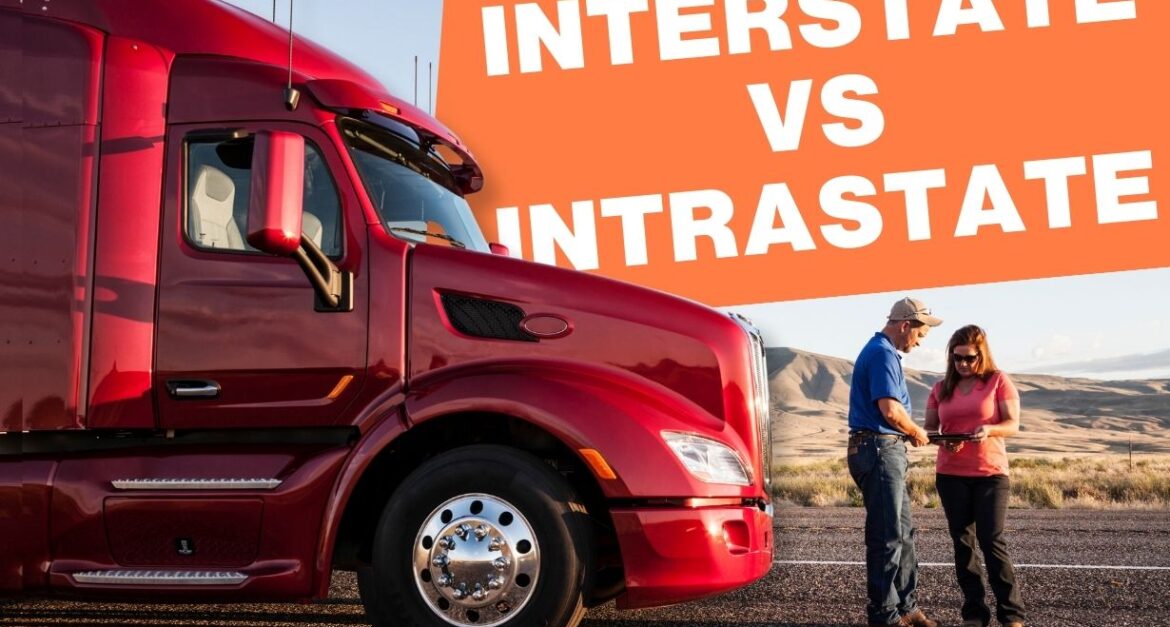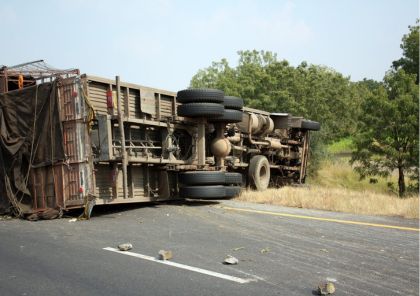
Ain’t nobody got time to read. How about listen while driving?
Interstate vs. Intrastate Trucking for Owner Operators: Everything You Need to Know
If you’re an owner operator, figuring out whether to run interstate (across state lines) or intrastate (within a single state) can feel like a massive decision. On one hand, interstate routes offer the potential for national reach and higher income. On the other, intrastate routes promise simpler paperwork, fewer fees, and more time at home. What’s the real deal? In this blog post, we’ll unpack the key distinctions between interstate and intrastate trucking, walk through the major pros and cons, and share insights to help you decide which path might fit your goals.
We’ll keep it conversational and easy to follow—think of it like chatting with a friend who’s been around the trucking block a few times. Let’s get rolling!
1. What Do Interstate and Intrastate Actually Mean?
- Interstate trucking means you’re hauling freight across state lines (and sometimes even into Canada or Mexico). If your trip starts in one state and ends in another, or if your load originated in a different state (even if you pick it up locally), that’s considered interstate commerce.
- Intrastate trucking stays within the borders of a single state. Everything—from pickup to drop-off—happens right in your home turf.
According to the DAT Freight & Analytics Guide to Interstate vs. Intrastate Trucking, the distinction isn’t just about physical distance. Even a short run can be classified as “interstate” if the freight is ultimately destined for another state.
2. Why Does This Distinction Matter?
Choosing between interstate or intrastate comes down to compliance requirements, operating costs, and lifestyle.
- Compliance: If you run interstate, you’ll need federal operating authority (an MC number), a USDOT number, and you must follow FMCSA regulations. Intrastate operations often answer to state-level rules only, which can be less paperwork-intensive.
- Operating Costs and Revenue: Interstate OTR (over-the-road) drivers often rack up more miles and can earn higher gross pay, but they also face bigger expenses (fuel, maintenance, multi-state tolls). Intrastate folks typically see lower fuel and maintenance costs but have limited earning potential since they can’t cross state lines.
- Lifestyle and Flexibility: Interstate trucking tends to require extended periods away from home, while intrastate routes often allow you to sleep in your own bed more frequently.
If you want a deeper dive into the nitty-gritty regulations, Truckstop has an excellent resource on Motor Carrier Registration and the different legal hoops you’ll have to jump through for each type of authority.
3. Key Differences at a Glance
Sometimes it helps to see things side by side. Here’s a quick comparison table that highlights the most notable contrasts between interstate and intrastate trucking:


4. Financial and Regulatory Implications
Operating Costs and Revenue
If you choose interstate, you’ll likely drive more miles, meaning you’ll spend more on fuel and maintenance. Plus, there’s a good chance you’ll hit multiple toll roads. However, those miles often translate into higher pay, especially if you’re paid by the mile or negotiate higher rates for long-haul loads.
By contrast, intrastate runs may involve shorter routes, which can reduce total fuel consumption. You may also avoid many toll roads entirely. On the flip side, local stop-and-go traffic could lower fuel efficiency and wear on your truck in different ways
Permits and Motor Carrier Registration
Interstate operators must handle Motor Carrier Registration at the federal level and deal with things like the International Registration Plan (IRP) for apportioned plates and the International Fuel Tax Agreement (IFTA). According to TheTruckersReport, this entails quarterly tax filings, fuel records, and an annual UCR fee. Intrastate-only truckers generally skip IFTA and IRP since they operate under a single state’s jurisdiction.
Insurance Considerations
Thanks to federal regulations, interstate carriers need at least $750,000 in liability coverage (though $1 million is more common). Many brokers and shippers won’t even talk to you unless you carry a $1 million policy. Intrastate minimums can be significantly lower (some states start at $50K-300K, depending on your vehicle’s weight), potentially cutting insurance premiums. For insights on how these insurance minimums can affect your bottom line, check out Truckstop’s in-depth guide.
5. Operational Flexibility and Lifestyle
Load Availability
An interstate authority unlocks a regional and nationwide freight market. If your home state is slow, you can look elsewhere. If you decide you want to haul produce from California or consumer goods to the East Coast, you have the freedom to do so. In intrastate trucking, you’re limited to a single state’s market—awesome if that state’s economy is booming, challenging if it’s not.
Schedules and Home Time
If being home regularly is a priority—maybe you’ve got kids in sports or you just hate living out of your truck—then intrastate can be a major plus. Many local or intrastate drivers are home daily or several times a week. Interstate routes often involve days or weeks on the road. A Quality Carriers overview notes that OTR drivers can be gone for long stretches, trading consistent home time for potentially higher earnings.
6. Specific Industries and Equipment
- Interstate: Commonly involves 18-wheelers hauling dry van, reefer, flatbed, or tanker loads cross-country. Industries might include retail distribution, agricultural produce, and long-distance manufacturing supply chains.
- Intrastate: You’ll see more specialized local vehicles like box trucks, tow trucks, dump trucks, or smaller flatbeds for construction or municipal work. If you’re in a heavily agricultural state, local hauls from farms to processing facilities may keep you busy.
For many owner operators, the decision is tied to equipment type. If you’re into specialized loads like oversize steel beams or cross-country reefer shipping, interstate may be the sweet spot. If you prefer focusing on local businesses or short hauls, intrastate is your lane.
7. Common Pros and Cons
Below are a few pros and cons to keep in mind—your mileage may vary (pun intended!).
Interstate Pros
- Higher Revenue Potential: More miles can mean bigger paychecks, especially for over-the-road loads.
- Broader Freight Network: Tap into a national pool of brokers, load boards, and shippers.
- Uniform Rules Across States: You follow federal rules consistently (though you’ll still handle some state-specific variations).
- Room for Business Growth: Easier to expand to other regions or hire additional drivers for broader coverage.
- Travel and Adventure: You’ll see different parts of the country and aren’t locked into one area.
Interstate Cons
- Higher Expenses: Fuel, tolls, maintenance, and lodging add up quickly on long-haul runs.
- Time Away From Home: Being on the road for weeks can strain family life and personal routines.
- Complex Compliance: Expect ELD usage, CDL requirements with a 21+ age limit, IFTA fuel tax filings, IRP registrations, and more.
- Higher Insurance Premiums: Federal minimums are higher, often pushing up monthly or yearly costs.
- Fierce Competition: You’re going head-to-head with massive fleets and other owner operators nationwide.
Intrastate Pros
- Simpler Paperwork: Typically no IFTA or IRP if you stay strictly in-state.
- Lower Operating Costs: Fewer miles mean less wear and tear, plus potentially cheaper insurance.
- Regular Home Time: Often home daily or on weekends, enabling a more balanced lifestyle.
- Local Market Expertise: Build tight-knit relationships with area shippers and become the go-to local hauler.
- Specialized Local Opportunities: Construction, utility work, local produce, or municipal contracts can keep you busy.
Intrastate Cons
- Limited Freight Pool: You’re restricted to your state’s economy, which can be risky if the market slows.
- Lower Gross Revenue: Short runs typically mean smaller payouts. You might do more loads to match interstate earnings.
- Possible Market Saturation: More local carriers fighting for the same loads can drive rates down.
- Fewer Backhauls: If you deliver to a remote part of the state, getting a return load might be tough.
- Regulatory “Gotchas”: Hauling a load that’s technically interstate commerce by accident (origin/destination out of state) can lead to fines if you only have intrastate authority.
8. Making the Right Choice
When choosing between interstate and intrastate trucking, it really comes down to personal and financial priorities. Ask yourself:
- What’s my ideal work-life balance?
- Want to be home daily or weekly? Intrastate might fit better.
- Okay with extended OTR runs to earn more? Interstate is calling your name.
- How comfortable am I with regulation and paperwork?
- Prefer minimal red tape and simpler operations? Intrastate is simpler.
- Willing to handle more complex compliance to access higher-paying loads? Go interstate.
- What does my local market look like?
- Live in a large state like Texas, California, or Florida with diverse industries? Intrastate might still offer plentiful, high-paying work.
- In a smaller state with fewer shipping opportunities? Interstate authority opens a bigger freight pool.
- What’s my financial runway?
- If you can handle the upfront costs of interstate (insurance, IRP, IFTA, etc.), it can pay off in the long run.
- On a tighter budget or just starting out? Intrastate might help you keep costs manageable while building up experience.
For more tips on whether or not to expand beyond state lines, TheTruckersReport offers a forum with real-world advice from owner-operators who have made the switch.
9. Final Thoughts
Deciding between interstate and intrastate trucking isn’t a one-size-fits-all situation. Each route has its own perks and pitfalls. Interstate gives you the freedom to roam far and wide, potentially earning more if you’re willing to take on additional expenses and deal with stricter compliance. Intrastate simplifies things—less paperwork, lower costs, and more time at home—but you’re limited by your state’s economy and freight availability.
Think about what matters most to you. Do you love the idea of traveling coast to coast, hauling a reefer load one day and a dry van the next, chasing the best rates across the country? Or are you happier serving a regional customer base with your box truck or occasionally running local tow trucks jobs, enjoying a more predictable routine? With a valid CDL, you’ve got options—just be honest with yourself about what you want out of your trucking business and lifestyle.
No matter which path you choose, keep learning, keep networking, and keep hustling to find the right lanes for your operation. Whether you stay intrastate or go full-on nationwide, the road to success is all about balancing your ambitions with the realities of costs, regulations, and personal well-being.